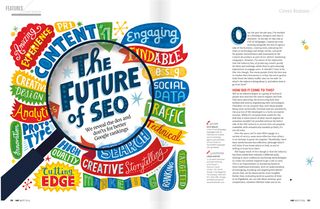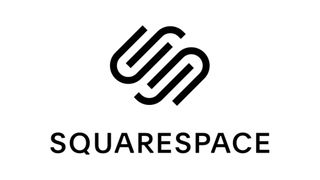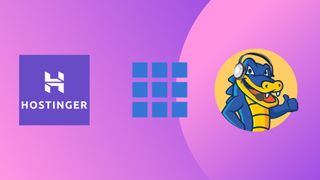8 essential SEO tips for your online portfolio
Natalie Brandweiner gives some key SEO advice to help beginner bloggers and your online portfolio.
Setting up a blog is a great way to get your name out in the industry and show your knowledge. But it's not enough to just churn out the articles, you need to make sure they're findable, too – particularly true if you're a freelancer wanting to get ranked in Google. To help you get started, we've listed some of the basic SEO tips and tricks to help you climb the search engine results pages (SERPs).
01. Website domain and hosting
While there are lots of free blog platforms out there, paying a small annual fee to upgrade to a custom URL will make your website more search engine friendly. Best practice for domains is to keep them short, free from numbers and characters, and containing relevant keywords to your business. However, if you are including keywords (e.g. GraphicDesignBristol.com), then it's important that the keywords you include match the majority of your content themes to avoid penalisation from Google.
Where you host the blog is equally important. There are three main options – subfolder, subdomain and separate domain – and while they all have benefits, generally the first two are more common and considered to give better SEO results.
02. Create unique content
Google frowns upon content that is duplicated across the web, so to avoid being penalised it's important to write your own content. There are lots of free tools out there that can help you understand popular topic being talked about, like Google Trends and Topsy, which analyse the conversations happening around specific keywords.
Including specific keywords within your blog articles helps Google to understand what your content is about and match it to relevant search queries. Be careful, though! When it comes to SEO, there are lots of tactics that you need to avoid – otherwise known as 'black hat' techniques – and stuffing an article with keywords or using unrelated keywords is one of them.
It's generally considered good practice to include a keyword in your blog title, one or two in sub headings (if using), at least one in bold or italics, and at least one in the page URL, too.

03. Permalinks
Which leads us to permalinks, those specific URLs created for each blog article. Once the article is published, you can go back into the CMS and edit the blog article URL to make it more searchable and so, more rankable. SEO expert Moz advises that you keep your URLs short, free from symbols (e.g. &, $ or @) and underscores, and include relevant keywords, which should already be the case if you've properly optimised your article title.
Get the Creative Bloq Newsletter
Daily design news, reviews, how-tos and more, as picked by the editors.
04. Categorising and tagging
You might not have much content on your site right now but as you populate the blog, categorising content will help search engines crawl your pages, and likely to help your page's performance in the SERPs . And while not so important from an SEO perspective, helping users find your content more easily keeps them on site for longer and more likely to return.
If you think of categories as the first tier of your blog's architecture (e.g. graphic design), tagging is the second tier that enables your readers to delve deeper into more specific topics (e.g. typography).
05. Optimise your images
Categorising your images can also help boost your article's SERPs ranking, and make your content findable in a Google image search. Properly optimise your images by titling the uploaded file with relevant keywords (not the blog article title) and by adding a description of the image in the 'Alt text' box. This ensures that if for any reason search engines have problems displaying the image, they can tell viewers what the content is about by showing the accompanying text instead.

06. Linking
Whether it's internal, external or backlinks, linking should be a key part of your SEO strategy. Linking your blog article to other articles within your domain not only keeps visitors onsite but also helps search engines to crawl your website much easier and better rank your pages in its listings.
Backlinks are highly important for SEO because other domains – especially highly authoritative sites like the BBC – linking to your website tells search engines that your content is relevant. As a result, search engines will give your content more authority and rank your content higher in the SERPs. There has been a lot of debate around backlinks but best practice is generally considered to be that you gain these links genuinely. Don't buy links; instead build relationships with other websites organically.
There is some debate around linking externally, too – some believe that in doing so you detract from your own content while others argue that in not doing so, you are failing to reference other sources and give Google signals as to what you're content's about. If you do link out, your anchor text should be keyword and topic specific, but also organically fit-in with your sentence.
07. Social media
Using social media channels to drive traffic back to your website is not only good for your page view figures, but your SEO ranking, too. Alongside returning your social media profiles in search accounts, Twitter also recently announced that your tweets will now show up in search rankings.
What's the importance of this? As well as properly optimising your Facebook Business Page or Twitter bio with properly optimised keywords (e.g. A London-based graphic designer specialising in creative web design), be mindful of the words you use in your tweets, too. However, be careful that you don't stuff every keyword imaginable into your copy as Google's likely to penalise against this too.
08. SEO plug-ins
Finally, there are lots of SEO plug-ins out there that can show you very quickly if your content is properly optimised or not. SEO Moz and Yoast SEO are two of the biggest and definitely worth the time adding to your site.
So before you hit that publish button, take a quick look back over these steps to make sure your content is properly optimised for the SERPs.
Words: Natalie Brandweiner
Images: David Saunders on Flickr
Natalie Brandweiner is a writer and social media expert, and is currently digital content marketer.
Like this? Read these!
- How to start a blog
- The ultimate guide to logo design
- Useful and inspiring flyer templates

Thank you for reading 5 articles this month* Join now for unlimited access
Enjoy your first month for just £1 / $1 / €1
*Read 5 free articles per month without a subscription

Join now for unlimited access
Try first month for just £1 / $1 / €1
The Creative Bloq team is made up of a group of design fans, and has changed and evolved since Creative Bloq began back in 2012. The current website team consists of eight full-time members of staff: Editor Georgia Coggan, Deputy Editor Rosie Hilder, Ecommerce Editor Beren Neale, Senior News Editor Daniel Piper, Editor, Digital Art and 3D Ian Dean, Tech Reviews Editor Erlingur Einarsson and Ecommerce Writer Beth Nicholls and Staff Writer Natalie Fear, as well as a roster of freelancers from around the world. The 3D World and ImagineFX magazine teams also pitch in, ensuring that content from 3D World and ImagineFX is represented on Creative Bloq.




